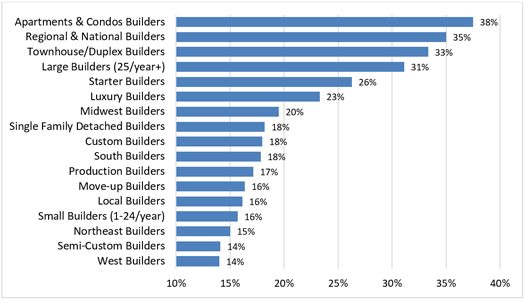

CONTINUOUS INSULATION, according to the IECC, is insulation that is continuous across all structural members without thermal bridges other than fasteners and service openings, and is installed on the interior, exterior, or is integral to any opaque surface of the building envelope.
Over the past few years, a lot has been said and written about continuous foam insulation in new homes, including the writing of the new building code requirements. Foam sheathing is one way to get more R-value while mitigating the impact of thermal bridging to improve energy performance of homes.
While we know about 15 percent of homes are now built with continuous foam insulation, we are still lacking details on specific usage patterns. In March 2017, Home Innovation Research Labs conducted a national survey of 300 home builders to learn more. Builders were asked about their primary wall insulation methods—material type and R-value of cavity insulation, sheathing material, and thickness of foam if used.
Results of our survey confirmed some “common sense” generalizations that have been made about insulation – e.g., more insulation is used in colder climates (on average, R-16 in the South and R-20 in the Northeast); custom homes have a higher total wall R-value than production homes (18.6 vs. 17.8), and luxury homes have a higher total wall R-value than starter homes (R-18.3 vs. 17.9). But when it came to use of exterior foam insulation, the results were less intuitive.
Builders Reporting Exterior Foam Sheathing
in their Typical Exterior Wall Assembly

A quick view of the graph above reveals some definite patterns. Interestingly, the highest usage of foam insulation was found in the smallest of homes. About 4 in 10 apartment and condo builders reported using foam sheathing, while fewer than 2 in 10 single-family builders reported foam. Further, more than 30 percent of larger builders reported foam wall sheathing, while only 16 percent of small builders reported using foam on walls.
Some notable differences in foam thickness were also found. Lower-volume builders typically had 1-inch or thicker foam, while higher-volume builders typically used ½-inch or ¾-inch foam. The vast majority of custom builders used 1-inch and thicker foam, while production and semi-custom builders used a roughly even mix of thinner and thicker foams.
The primary conclusion we can make from this analysis is builders of various types are achieving the R-value suitable for their climate, but they are getting it by different means. Builders of multifamily and smaller homes and higher-volume builders are reaching it primarily through exterior foam sheathing; other types of builders are more likely to achieve their desired results through deeper wall cavities or higher R-value cavity insulation, such as closed-cell foam.
Looking for more information on building product trends among home builders in different markets? Home Innovation’s expert marketing research team can help. Contact us today to find out more about our off-the-shelf reports, or what’s possible with custom surveys and reports.